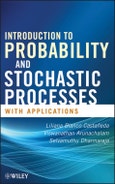An easily accessible, real–world approach to probability and stochastic processes
Introduction to Probability and Stochastic Processes with Applications presents a clear, easy–to–understand treatment of probability and stochastic processes, providing readers with a solid foundation they can build upon throughout their careers. With an emphasis on applications in engineering, applied sciences, business and finance, statistics, mathematics, and operations research, the book features numerous real–world examples that illustrate how random phenomena occur in nature and how to use probabilistic techniques to accurately model these phenomena.
The authors discuss a broad range of topics, from the basic concepts of probability to advanced topics for further study, including Itô integrals, martingales, and sigma algebras. Additional topical coverage includes:
- Distributions of discrete and continuous random variables frequently used in applications
- Random vectors, conditional probability, expectation, and multivariate normal distributions
- The laws of large numbers, limit theorems, and convergence of sequences of random variables
- Stochastic processes and related applications, particularly in queueing systems
- Financial mathematics, including pricing methods such as risk–neutral valuation and the Black–Scholes formula
Extensive appendices containing a review of the requisite mathematics and tables of standard distributions for use in applications are provided, and plentiful exercises, problems, and solutions are found throughout. Also, a related website features additional exercises with solutions and supplementary material for classroom use. Introduction to Probability and Stochastic Processes with Applications is an ideal book for probability courses at the upper–undergraduate level. The book is also a valuable reference for researchers and practitioners in the fields of engineering, operations research, and computer science who conduct data analysis to make decisions in their everyday work.
Table of Contents
Foreword xiiiPreface xv
Acknowledgments xvii
Introduction xix
1. Basic Concepts 1
1.1 Probability Space 1
1.2 Laplace Probability Space 13
1.3 Conditional Probability and Event Independence 18
1.4 Geometric Probability 34
Exercises 36
2. Random Variables and their Distributions 49
2.1 Definitions and Properties 49
2.2 Discrete Random Variables 59
2.3 Continuous Random Variables 64
2.4 Distribution of a Function of a Random Variable 69
2.5 Expected Value and Variance of a Random Variable 77
Exercises 97
3. Some Discrete Distributions 111
3.1 Discrete Uniform, Binomial and Bernoulli Distributions 111
3.2 Hypergeometric and Poisson Distributions 119
3.3 Geometric and Negative Binomial Distributions 128
Exercises 133
4. Some Continuous Distributions 141
4.1 Uniform Distribution 141
4.2 Normal Distribution 147
4.3 Family of Gamma Distribution 158
4.4 Weibull Distribution 167
4.5 Beta Distribution 169
4.6 Other Continuous Distributions 173
Exercises 178
5. Random Vectors 189
5.1 Joint Distribution of Random Variables 189
5.2 Independent Random Variables 206
5.3 Distribution of Functions of a Random Vector 214
5.4 Covariance and Correlation Coefficient 224
5.5 Expected Value and Variance of a Random Vector 232
5.6 Generating Functions 236
Exercises 247
6. Conditional Expectation 261
6.1 Conditional Distribution 261
6.2 Conditional Expectation given a –algebra 276
Exercises 283
7. Multivariate Normal Distribution 291
7.1 Multivariate Normal Distribution 291
7.2 Distribution of Quadratic Forms of Multivariate Normal Vectors 298
Exercises 304
8. Limit Theorems 307
8.1 The Weak Law of Large Numbers 307
8.2 Convergence of Sequences of Random Variables 313
8.3 The Strong Law of Large Numbers 316
8.4 Central Limit Theorem 323
Exercises 328
9. Introduction to Stochastic Processes 333
9.1 Definitions and Properties 334
9.2 Discrete Time Markov Chain 338
9.3 Continuous Time Markov Chains 364
9.4 Poisson Process 374
9.5 Renewal Processes 383
9.6 Semi–Markov process 393
Exercises 399
10. Introduction to Queueing Models 409
10.1 Introduction 409
10.2 Markovian Single Server Models 411
10.3 Markovian Multi Server Models 423
10.4 Non–Markovian Models 432
Exercises 449
11. Stochastic Calculus 453
11.1 Martingales 453
11.2 Brownian Motion 464
11.3 Itô Calculus 473
Exercises 484
12. Introduction to Mathematical Finance 489
12.1 Financial Derivatives 490
12.2 Discrete–time Models 496
12.3 Continuous–time models 513
12.4 Volatility 523
Exercises 525
Appendix A. Basic Concepts on Set Theory 529
Appendix B. Introduction to Combinatorics 535
Appendix C. Topics on Linear Algebra 545
Appendix D. Statistical Tables 547
Problem Solutions 559
References 575
Bibliography 575
Glossary 579
Index 583








